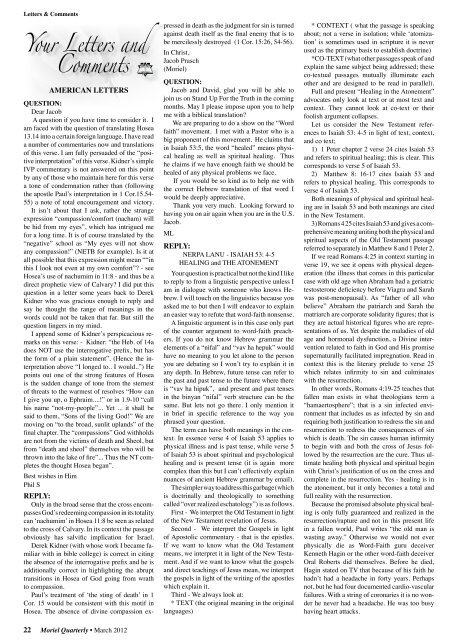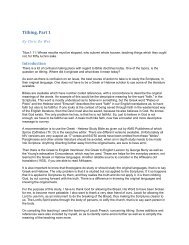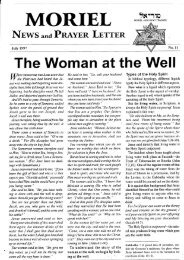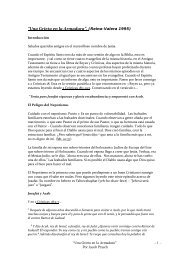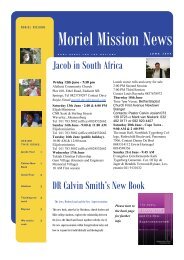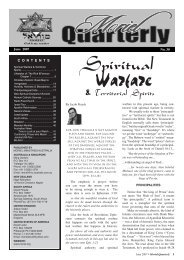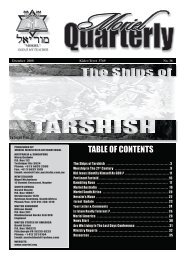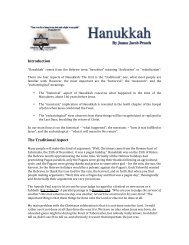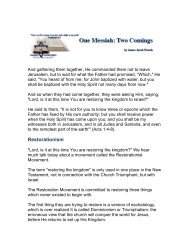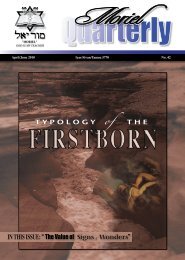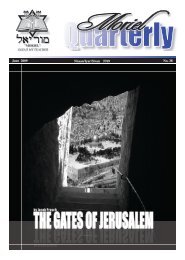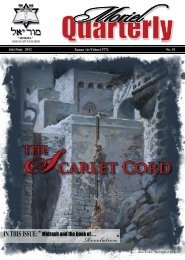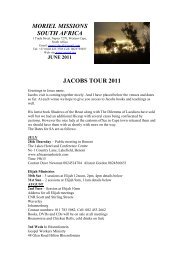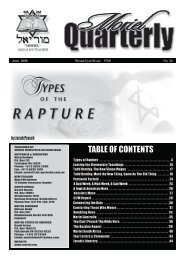The Legacy of Jacob - Moriel Ministries
The Legacy of Jacob - Moriel Ministries
The Legacy of Jacob - Moriel Ministries
You also want an ePaper? Increase the reach of your titles
YUMPU automatically turns print PDFs into web optimized ePapers that Google loves.
Letters & Comments<br />
Your Letters and<br />
Comments<br />
AMERICAN LETTERS<br />
QUESTION:<br />
Dear <strong>Jacob</strong><br />
A question if you have time to consider it. I<br />
am faced with the question <strong>of</strong> translating Hosea<br />
13.14 into a certain foreign language. I have read<br />
a number <strong>of</strong> commentaries now and translations<br />
<strong>of</strong> this verse. I am fully persuaded <strong>of</strong> the “positive<br />
interpretation” <strong>of</strong> this verse. Kidner’s simple<br />
IVP commentary is not answered on this point<br />
by any <strong>of</strong> those who maintain here for this verse<br />
a tone <strong>of</strong> condemnation rather than (following<br />
the apostle Paul’s interpretation in 1 Cor.15.54-<br />
55) a note <strong>of</strong> total encouragement and victory.<br />
It isn’t about that I ask, rather the strange<br />
expression “compassion/comfort (nacham) will<br />
be hid from my eyes”, which has intrigued me<br />
for a long time. It is <strong>of</strong> course translated by the<br />
“negative” school as “My eyes will not show<br />
any compassion!” (NETB for example). Is it at<br />
all possible that this expression might mean ““in<br />
this I look not even at my own comfort” - see<br />
Hosea’s use <strong>of</strong> nachumim in 11:8 - and thus be a<br />
direct prophetic view <strong>of</strong> Calvary I did put this<br />
question in a letter some years back to Derek<br />
Kidner who was gracious enough to reply and<br />
say he thought the range <strong>of</strong> meanings in the<br />
words could not be taken that far. But still the<br />
question lingers in my mind.<br />
I append some <strong>of</strong> Kidner’s perspicacious remarks<br />
on this verse: - Kidner: “the Heb. <strong>of</strong> 14a<br />
does NOT use the interrogative prefix, but has<br />
the form <strong>of</strong> a plain statement”. (Hence the interpretation<br />
above “I longed to.. I would..”) He<br />
points out one <strong>of</strong> the strong features <strong>of</strong> Hosea<br />
is the sudden change <strong>of</strong> tone from the sternest<br />
<strong>of</strong> threats to the warmest <strong>of</strong> resolves “How can<br />
I give you up, o Ephraim....!” or in 1.9-10 “call<br />
his name “not-my-people”... Yet ... it shall be<br />
said to them, “Sons <strong>of</strong> the living God!” We are<br />
moving on “to the broad, sunlit uplands” <strong>of</strong> the<br />
final chapter. <strong>The</strong> “compassions” God withholds<br />
are not from the victims <strong>of</strong> death and Sheol, but<br />
from “death and sheol” themselves who will be<br />
thrown into the lake <strong>of</strong> fire”... Thus the NT completes<br />
the thought Hosea began”.<br />
Best wishes in Him<br />
Phil S<br />
REPLY:<br />
Only in the broad sense that the cross encompasses<br />
God’s redeeming compassion in its totality<br />
can ‘nachumim’ in Hosea 11:8 be seen as related<br />
to the cross <strong>of</strong> Calvary. In its context the passage<br />
obviously has salvific implication for Israel.<br />
Derek Kidner (with whose work I became familiar<br />
with in bible college) is correct in citing<br />
the absence <strong>of</strong> the interrogative prefix and he is<br />
additionally correct in highlighting the abrupt<br />
transitions in Hosea <strong>of</strong> God going from wrath<br />
to compassion.<br />
Paul’s treatment <strong>of</strong> ‘the sting <strong>of</strong> death’ in 1<br />
Cor. 15 would be consistent with this motif in<br />
Hosea. <strong>The</strong> absence <strong>of</strong> divine compassion expressed<br />
in death as the judgment for sin is turned<br />
against death itself as the final enemy that is to<br />
be mercilessly destroyed (1 Cor. 15:26, 54-56).<br />
In Christ,<br />
<strong>Jacob</strong> Prasch<br />
(<strong>Moriel</strong>)<br />
QUESTION:<br />
<strong>Jacob</strong> and David, glad you will be able to<br />
join us on Stand Up For the Truth in the coming<br />
months. May I please impose upon you to help<br />
me with a biblical translation<br />
We are preparing to do a show on the “Word<br />
faith” movement. I met with a Pastor who is a<br />
big proponent <strong>of</strong> this movement. He claims that<br />
in Isaiah 53:5, the word “healed” means physical<br />
healing as well as spiritual healing. Thus<br />
he claims if we have enough faith we should be<br />
healed <strong>of</strong> any physical problems we face.<br />
If you would be so kind as to help me with<br />
the correct Hebrew translation <strong>of</strong> that word I<br />
would be deeply appreciative.<br />
Thank you very much. Looking forward to<br />
having you on air again when you are in the U.S.<br />
<strong>Jacob</strong>.<br />
ML<br />
REPLY:<br />
NERPA LANU - ISAIAH 53: 4-5<br />
HEALING and THE ATONEMENT<br />
Your question is practical but not the kind I like<br />
to reply to from a linguistic perspective unless I<br />
am in dialogue with someone who knows Hebrew.<br />
I will touch on the linguistics because you<br />
asked me to but then I will endeavor to explain<br />
an easier way to refute that word-faith nonsense.<br />
A linguistic argument is in this case only part<br />
<strong>of</strong> the counter argument to word-faith preachers.<br />
If you do not know Hebrew grammar the<br />
elements <strong>of</strong> a “nifal” and “vav ha hepuk” would<br />
have no meaning to you let alone to the person<br />
you are debating so I won’t try to explain it in<br />
any depth. In Hebrew, future tense can refer to<br />
the past and past tense to the future where there<br />
is “vav ha hipuk”, and present and past tenses<br />
in the binyan “nifal” verb structure can be the<br />
same. But lets not go there. I only mention it<br />
in brief in specific reference to the way you<br />
phrased your question.<br />
<strong>The</strong> term can have both meanings in the context.<br />
In essence verse 4 <strong>of</strong> Isaiah 53 applies to<br />
physical illness and is past tense, while verse 5<br />
<strong>of</strong> Isaiah 53 is about spiritual and psychological<br />
healing and is present tense (it is again more<br />
complex than this but I can’t effectively explain<br />
nuances <strong>of</strong> ancient Hebrew grammar by email).<br />
<strong>The</strong> simpler way to address this garbage (which<br />
is doctrinally and theologically to something<br />
called “over realized eschatology”) is as follows.<br />
First - We interpret the Old Testament in light<br />
<strong>of</strong> the New Testament revelation <strong>of</strong> Jesus.<br />
Second - We interpret the Gospels in light<br />
<strong>of</strong> Apostolic commentary - that is the epistles.<br />
If we want to know what the Old Testament<br />
means, we interpret it in light <strong>of</strong> the New Testament.<br />
And if we want to know what the gospels<br />
and direct teachings <strong>of</strong> Jesus mean, we interpret<br />
the gospels in light <strong>of</strong> the writing <strong>of</strong> the apostles<br />
which explain it.<br />
Third - We always look at:<br />
* TEXT (the original meaning in the original<br />
languages)<br />
* CONTEXT ( what the passage is speaking<br />
about; not a verse in isolation; while ‘atomization’<br />
is sometimes used in scripture it is never<br />
used as the primary basis to establish doctrine)<br />
*CO-TEXT (what other passages speak <strong>of</strong> and<br />
explain the same subject being addressed; these<br />
co-textual passages mutually illuminate each<br />
other and are designed to be read in parallel).<br />
Full and present “Healing in the Atonement”<br />
advocates only look at text or at most text and<br />
context. <strong>The</strong>y cannot look at co-text or their<br />
foolish argument collapses.<br />
Let us consider the New Testament references<br />
to Isaiah 53: 4-5 in light <strong>of</strong> text, context,<br />
and co text;<br />
1) 1 Peter chapter 2 verse 24 cites Isaiah 53<br />
and refers to spiritual healing; this is clear. This<br />
corresponds to verse 5 <strong>of</strong> Isaiah 53.<br />
2) Matthew 8: 16-17 cites Isaiah 53 and<br />
refers to physical healing. This corresponds to<br />
verse 4 <strong>of</strong> Isaiah 53.<br />
Both meanings <strong>of</strong> physical and spiritual healing<br />
are in Isaiah 53 and both meanings are cited<br />
in the New Testament.<br />
3) Romans 4 25 cites Isaiah 53 and gives a comprehensive<br />
meaning uniting both the physical and<br />
spiritual aspects <strong>of</strong> the Old Testament passage<br />
referred to separately in Matthew 8 and 1 Peter 2.<br />
If we read Romans 4:25 in context starting in<br />
verse 19, we see it opens with physical degeneration<br />
(the illness that comes in this particular<br />
case with old age when Abraham had a geriatric<br />
testosterone deficiency before Viagra and Sarah<br />
was post-menopausal). As “father <strong>of</strong> all who<br />
believe” Abraham the patriarch and Sarah the<br />
matriarch are corporate solidarity figures; that is<br />
they are actual historical figures who are representations<br />
<strong>of</strong> us. Yet despite the maladies <strong>of</strong> old<br />
age and hormonal dysfunction, a Divine intervention<br />
related to faith in God and His promise<br />
supernaturally facilitated impregnation. Read in<br />
context this is the literary prelude to verse 25<br />
which relates infirmity to sin and culminates<br />
with the resurrection.<br />
In other words, Romans 4:19-25 teaches that<br />
fallen man exists in what theologians term a<br />
“hamaertosphere”; that is a sin infected environment<br />
that includes us as infected by sin and<br />
requiring both justification to redress the sin and<br />
resurrection to redress the consequences <strong>of</strong> sin<br />
which is death. <strong>The</strong> sin causes human infirmity<br />
to begin with and both the cross <strong>of</strong> Jesus followed<br />
by the resurrection are the cure. Thus ultimate<br />
healing both physical and spiritual begin<br />
with Christ’s justification <strong>of</strong> us on the cross and<br />
complete in the resurrection. Yes - healing is in<br />
the atonement, but it only becomes a total and<br />
full reality with the resurrection.<br />
Because the promised absolute physical healing<br />
is only fully guaranteed and realized in the<br />
resurrection/rapture and not in this present life<br />
in a fallen world, Paul writes “the old man is<br />
wasting away.” Otherwise we would not ever<br />
physically die as Word-Faith guru deceiver<br />
Kenneth Hagin or the other word-faith deceiver<br />
Oral Roberts did themselves. Before he died,<br />
Hagin stated on TV that because <strong>of</strong> his faith he<br />
hadn’t had a headache in forty years. Perhaps<br />
not, but he had four documented cardio-vascular<br />
failures. With a string <strong>of</strong> coronaries it is no wonder<br />
he never had a headache. He was too busy<br />
having heart attacks.<br />
22 <strong>Moriel</strong> Quarterly • March 2012


